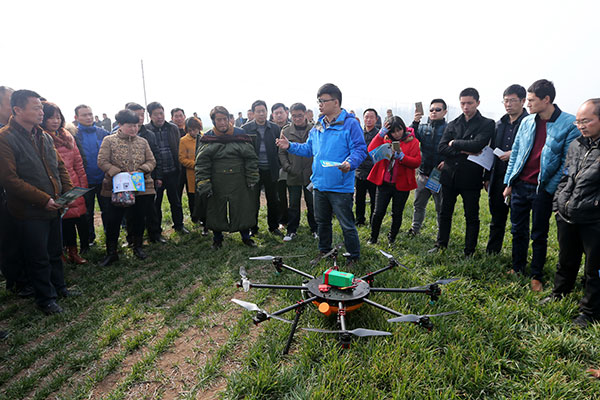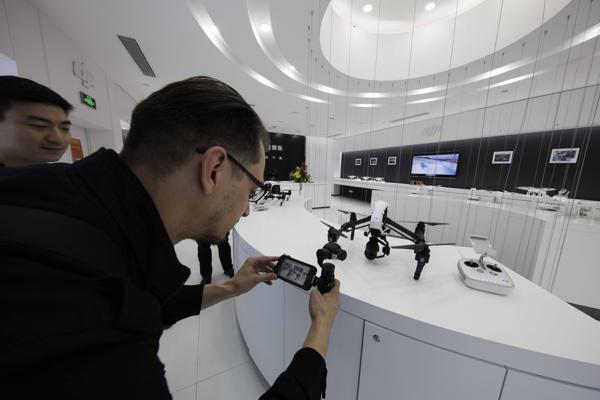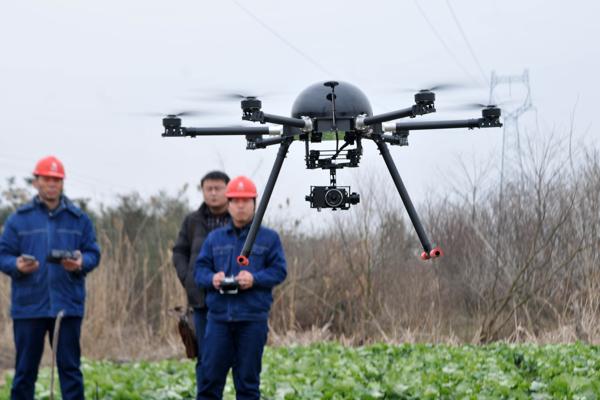
A technician demonstrates to some farmers in Huaibei, Anhui province how to use a drone in farm production.[Photo provided to China Daily]
Ehang Inc, a Chinese drone maker, created a flutter at the Consumer Electronics Show in Las Vegas in January with its latest product, the world’s first drone capable of carrying a human passenger.
The world sat up and took notice that manufacture of unmanned aerial vehicles or UAVs-drones in common parlance-is now the forte of Chinese companies, never mind China Inc lags in aircraft-making capability.
Shenzhen, Guangdong-based DJI-Innovations Technology Co leads with a 70 percent share of the world’s consumer drone market. It also commands a 47 percent share of the US market. “Our leading position is on account of the high level of our technologies,” said Wang Fan, the company’s vice-president.
Its 2015 net profit was $250 million. The company estimates it will rise by 86 percent to $460 million this year.

A foreigner takes photos of a DJI-made drone.[Photo provided to China Daily]
Its confidence stems from the fact that the company has the world’s best flight control system in the drone industry. Wang said the system is analogous to the brain. It makes the drone flight stable and safe. “We developed the flight control system all by ourselves.”
Real-time picture communication system is also key for civilian drones, Wang said.
DJI-Innovation’s light bridge system can transmit high-definition images to a distance of up to 5 kilometers, much advanced than other manufacturers, he said.
The camera stabilizer is also important for consumer drones as the drones usually reach up to 400 to 500 meters in altitude and could face strong winds.
“The camera stabilizer is an attractive technology for the public as it reduces the camera shaking and ensures top picture quality,” said Wang.
DJI-Innovation has a tie-up with Hasselblad, the high-end optical camera manufacturer from Switzerland, to develop its own cameras customized for use in drones, Wang said.
Other Chinese drone builders are also improving their technologies and innovating to make cutting-edge products.

Power technicians operate a drone to check local 220kV overhead lines in Anhui.[Photo provided to China Daily]
For instance, Guangzhou-based Ehang is testing out the Ehang 184, its passenger-carrying drone, and expects to find out more applications for it this year, said Xiong Yifang, the company’s co-founder and chief marketing officer.
He said the company is also working on an emergency ejection system for the Ehang 184 to make sure the safety of the passenger does not get compromised, although it is not sure yet when the product will be sold.
“We used a method to build up the Ehang 184 that is totally different from the one used to build traditional passenger planes,” Xiong said.
Chinese aircraft manufacturers still need time to master the science of achieving exacting precision in details, he said. But passenger-carrying drones are different as the manufacturer uses enough back-ups to make sure safety, including aspects related to rotors and batteries, is 100 percent, Xiong said.
“Actually, the idea came from the information technology industry as Ehang’s engineers and designers had worked on IT systems in the past,” he said.

DJI headquarters in Shenzhen, Guangdong province.[Photo provided to China Daily]
China’s civilian drone industry benefits from innovations happening outside it but, in terms of geography, are almost next door, so to say. “We can get all the sensor parts we need from no farther than 100 kilometers from our headquarters in Guangzhou,” said Xiong. “Foreign manufacturers cannot even imagine this could be possible.”
The manufacture of sensor parts in Guangdong province is a legacy of the Chinese mobile phone industry, which boomed here 10 years ago. There are plenty of parts suppliers as well as co-packers in the area.
“The mobile phone industry provided us ease of production in the area. The cost of production is also very low as the price of sensors is not high due to the negligible cost of transport,” Xiong said. Small wonder, most of the civilian drone builders have set up shop in Guangdong province.
According to Shenzhen District Customs, around 99.9 percent of Chinese drone exports were from Shenzhen, Guangdong province, in the first seven months of 2015.
Then, there is China’s mobile Internet industry, which provides talents, technology and capital for the civilian drone industry. Most of the core technologies used in civilian drones are from the IT industry.
Among Ehang’s 300 staff, over half are in the research-and-development team, said Xiong. “Most of them majored in computer science from well-known domestic universities and have rich experience in the information technology industry.”
Some technologies that Ehang uses, like motion sensors and virtual eyeglass, have been in use globally, although Ehang is the first firm to use them in UAVs, after innovating its products.
“The advanced information technology is the base of our drone development and we also improve some technologies, including the flight control system,” Xiong said.
Given the well-established manufacturing base and the associated industrial chain, it is possible for Chinese drone-makers to supply to the whole world, some experts said.
In the civilian drone segment, Chinese companies are strong in avionics and complete machine design, said Zhang Feng, secretary general of the Aircraft Owners and Pilots Association of China.
There are 300 to 400 civilian drone enterprises in China at present, involving over 10,000 employees, according to the AOPA.
Chinese manufacturers are not satisfied with just making civilian drones. For some at least, industrial drones represent one of the future opportunities. No Chinese company leads in this segment yet.
Compared with consumer drones, industrial drones need more complicated technologies but yield higher profits as well.
Ehang has already launched two industrial drone products, which mainly work on environment protection, forestry and aerial photography, said Xiong.
“We applied the concept of ‘intelligent flying’ to our industrial products. They could fly according to pre-planned flight points and save on the cost of human resources,” he said.
Despites the small scale of its sales of industrial drones, the company has been receiving queries from potential buyers since August 2015.
The manufacturer has set for itself the tasks of educating consumers and displaying models of its drones at some industries, Xiong said. Drones can make a difference to many industries, he said. “We need to show them what drones can do now.”
Similarly, DJI-Innovation has made development of industrial drones one of its future goals.
It has already launched its first product exclusively for the agriculture industry. Its drone with a built-in pesticide-sprayer protects crops. It hit the market in November 2015.
DJI-Innovation has tied up with a US-based company to develop thermal-imaging cameras for inspecting power lines, bridges and solar panels, said Wang Fan, vice president of DJI-Innovation. “We are entering new areas with these products.”
The advent of such products is gradually lowering some industries’ cost of operations. For example, where high-cost helicopter services were the norm, low-cost drone services are used now. That is why, aerial scenes are now commonplace in TV programs and movies, said Wang.
Drones could help farmers to continue in agriculture rather than leaving rural areas in search of jobs in urban areas, he said.
Against this background, a host of businesses have expressed their willingness to use drones in operations like firefighting, search-and-rescue, material delivery, mapping and meteorology, Wang said. “But our supply can’t meet all of that demand.”
While the use of drones in inspection of power lines and in agriculture will likely continue, the products are still in the testing stage in other industries, said Yu Zexuan, deputy general manager of Hubei province-based Ewatt Co Ltd, one of the main industrial drone makers in China.
Yu is confident Chinese companies will sooner or later lead the segment of industrial drones as well because technology continues to be improved and more industries will likely use drones.
